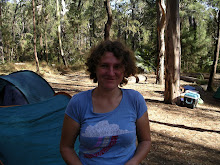
Schoolgirls sit in the girls' section of a school in Bamozai, near Gardez, Paktya Province, Afghanistan. The school has no building; classes are held outdoors in the shade of an orchard, by Capt. John Severns.
This picture is the 'picture of the day' in WikiPedia Commons. Thanks to the Commons licensing of pictures and information in WikiPedia reproduction on a educational bases is allowed. When reading or writing, pictures provide instant information about the text and can guide all types of learners.
WikiPedia is an free online encyclopedia that can be added to or modified by anyone. There are strict controls to keep the information accurate so this is a good information resource for everyone. It is built around a wiki so there is also discussion pages and history logs. It is very easy to use and has WikiProjects for eduction and books (there are more) to improve coverage on such topics.
Given the accuracy, ease of use, selection of foreign language, numerous hyperlinks to explain every word, contents and references this is an excellent resource for independent learning at home or at school. Students can work at their own pace and find authentic hyperlinks - for example if researching pollution you may come across Green Peace.
I have searched learning frameworks and other course content and now I am in school I have researched every topic I am teaching. It always provides a good base to work from and I have used the pictures, references and hyperlinks for further research and presentations. With the collated information I have created learning experiences that 'extend and refine knowledge' (Dimensions of Learning 3 - Marzano, R & Pickering, D 1997). Comparing and classifying information are the two I used most with my Year 2 class. Information I collected and distributed so the learner-centred experience comes from their group work to place the information in the correct spots and then choose their follow-up task.
To make sure my Year 2 students learn deeply, it is important to understand their learning styles. I have mentioned some of these in previous blogs and would like to focus on the Felder and Silverman model and link it to using WikiPedia. The bullet points below discuss their ideas that led to the Index of Learning Styles - a questionnaire to determine the type of instruction the student is most comfortable with and is most effective.
- What type of information does the student preferentially perceive?:
Sensory - sights, sounds and physical sensations OR
Intuitive - memories, thoughts and insights.
Verbal - written and spoken explanations.
Reflectively - through introspection.
Globally - in large 'big picture' jumps.
Intuitive - memories, thoughts and insights.
- What type of sensory information is most effectively perceived?:
Verbal - written and spoken explanations.
- How does the student prefer to process information?:
Reflectively - through introspection.
- How does the student characteristically progress towards understanding?:
Globally - in large 'big picture' jumps.
You can see that research using WikiPedia would help the visual and verbal learners, and the sequential and global learners. The learner-centred activity designed around WikiPedia as a resource should consider the other types of learners. Engaging in discussion and debate, and presenting your results as a podcast or video may assist. Working in mixed groups would allow the different learning styles to work together to complete the project.
Thinking about this model, the eight intelligences developed by Gardner, Jungs theory and Dimensions of Learning one and five (Marzano, R & Pickering, D 1997) there are lots to think about when asking yourself lynch's Learning Management Question no.3 - 'How does my learner best learn?'.
Look back at the picture of the school girls and reflect on how far we have come with education and the freedom of knowledge, but there are many who are without this. How long until technology reaches all and how much would it have changed by then to do so? any comments?
Thanks
Johanna
References
Felder and Silverman model (1988).
www4.ncsu.edu/unity/lockers/users/f/felder/public/ILSpage.html
R.M. Felder and J.E. Spurlin, "Applications, Reliability, and Validity of the Index of Learning Styles," Intl. Journal of Engineering Education, 21(1), 103-112 (2005). A validation study of the Index of Learning Styles.
Marzano, R & Pickering, D. (1997). Dimensions of Learning: teacher's manual (2nd ed.). Alexandria : ASCD.

Hi Johanna, thanks for much for mentioning Wikipedia Commons, that is exactly what I need and have been looking for but didn't realise there was a Wikipedia one. I believe relevant and quality images are essential when using them in presenting information and have been having trouble finding images I can use that won't infringe copyright laws outside of Flickr and government websites. So thanks again!
ReplyDeleteCarolyne
Hi Carolyne,
ReplyDeleteI understand - it is so time consuming finding pictures to use in the classroom and some of the most amazing shots have copyright. I have started taking my own where I can. We are studying ants in my Year 2 class so I have prepared a slideshow using Picasa on green ants in my garden.
Thanks so much for your comments.
Johanna
What a fun and insightful look at the world of Wikipedia! It’s fascinating how this platform has become such a go-to resource for information. However, as your post highlights, it’s important to consider the quality and accuracy of the content we consume. When it comes to writing, whether for Wikipedia or any other medium, clear, engaging, and well-researched writing is key. If you're looking to improve your writing skills, creative write course can help you master storytelling, develop strong narratives, and create content that resonates. Thanks for sharing this interesting perspective on the world of digital information!
ReplyDelete